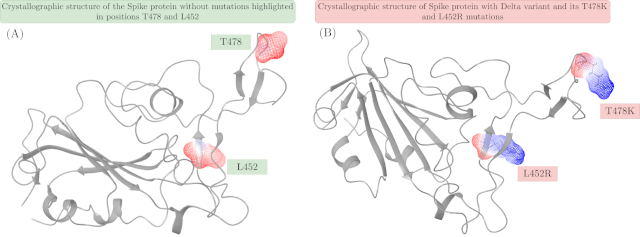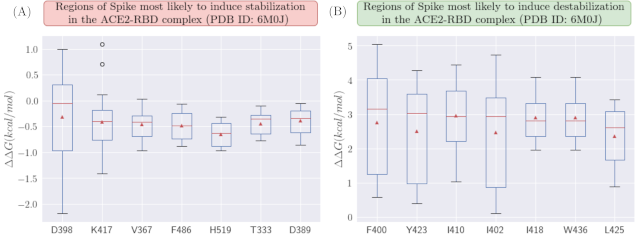Profile of new SARS-CoV-2 mutations in Spike protein and electrostatic potential of the Delta variant
- Home
- Trabalhos
ÁREA
Físico-Química
Autores
Lima de Oliveira, M.D. (FEDERAL UNIVERSITY OF AMAZONAS) ; Teixeira de Oliveira, K.M. (FEDERAL UNIVERSITY OF AMAZONAS) ; Bezerra Cordeiro, I. (FEDERAL UNIVERSITY OF AMAZONAS) ; Nunes da Silva, J. (FEDERAL UNIVERSITY OF AMAZONAS) ; de Souza Santos, C. (FEDERAL UNIVERSITY OF AMAZONAS) ; Holanda Bessa Neto, J.A. (FEDERAL UNIVERSITY OF AMAZONAS) ; de Freitas, R. (FEDERAL UNIVERSITY OF AMAZONAS)
RESUMO
The variants of SARS-CoV-2 are causing great concern to everyone. The most recent is the Delta variant that emerged in India, with signs of increased transmissibility. Thus, we seek to understand the impact on electrostatic distribution as a result of L452R and T478K mutations in Spike protein. These calculations were performed by the APBS algorithm when solving the Poisson- Boltzmann equation. In this we found that these mutations favored a more positive potential. In addition, we use a genetic algorithm to predict possible new mutations in Spike that can also maximize the interaction with antibodies, where we found the D398I and N422L mutations. Therefore, we hope that these results can help in a better understanding of the SARS-CoV-2 virus.
Palavras Chaves
SARS-CoV-2; Delta variant; Genetic algorithm
Introdução
The peaks in the number of daily infections and deaths from COVID-19 are mainly due to the emergence of new variants of concern (VOC) (HARVEY, CARABELLI, et al., 2021). The most recent variant is the B.1.617.2 (Delta variant), considered to be of concern and already circulating throughout the world, including Brazil. A research found that Delta is about 40-60% more infectious than the Alpha variant (B.1.1.7) (FISMAN, TUITE, 2021). Finally, it is important to highlight that it has 2 (two) new mutations not present in the previous strains, in detail we have in the RBD region: L452R, T478K. Furthermore, it features the P681R mutations that enhance the receptor cleavage process. Nevertheless, many studies show that fully vaccinated people are likely to be protected against this variant (EDARA, PINSKY, et al., 2021). However, in poorer countries, where access to vaccination is scarce, the impact of the Delta variant tends to be more worrying. In molecular terms, the Spike protein is the key to how the virus interacts with human cells, as in the immune response, and that is why this region is much more susceptible to mutations. Certainly predicting new emerging mutations of SARS-CoV-2, in addition to those that could maximize antibody-antigen interaction, is a very promising way to improve currently existing vaccines. Thus, in this research, we sought to understand the effect in electrostatic potential as a consequence of Delta variant mutations and possible new mutations predicted by a genetic algorithm on the stability and affinity of antibody-antigen and ACE2-RBD complexes.
Material e métodos
The electrostatic distribution surface was calculated for the L452R (PDB ID: 7ORB) and T478K (PDB ID: 7ORA) mutations of the Delta variant, in addition to the wild-type form (PDB ID: 7OR9) (LIU, GINN, et al., 2021). At the moment they are the only crystallographic structures available for the Delta variant, however with high resolutions of respectively 2.5 Å, 2.6 Å and 2.34 Å. All potentials were calculated by the Poisson-Boltzmann method using the algorithm APBS (JURRUS, ENGEL, et al., 2018) integrated with Schrodinger Maestro 2021-2 software (SCHRÖDINGER LLC, 2021). All structures were previously prepared using the same software, where the missing hydrogen atoms were added and the correction of steric conflicts was carried out by means of structural minimization. During the test of mutation combinations, we used the online tool MAESTROweb (LAIMER, HIEBL-FLACH, et al., 2016), which performed a search for combinations using an evolutionary genetic algorithm where the number of concurrent mutations was adjusted to 3 (three). Furthermore, we simulated under acidic (pH ≈ 5.5), neutral (pH ≈ 7.4) and basic (pH ≈ 8.5) conditions. The choice of pH values was to simulate the stomach in the acidic condition, the lungs in the neutral condition and finally the intestine in the basic condition. In addition, we used the functionality "Sensitivity profile" which helped us to estimate regions most likely to mutate of the Spike protein. In the stability studies, we adopted for the ACE2-RBD complex (PDB ID: 6M0J) (LAN, GE, et al., 2020) with a resolution of 2.45 Å and antibody- antigen (PDB ID: 7BWJ) (JU, ZHANG, et al., 2020) with a resolution of 2.85 Å, as they are widely studied structures and with little missing residues.
Resultado e discussão
We can see that Delta variant mutations have a more positive electrostatic
potential compared to the original amino acids. This is due to the
substitution for Lysine (T478K) which is more electrically positive, in
addition to the transition to Arginine (L452R) which also has a positive
electrical charge (see Figure 1).
With the help of the software MAESTROweb we will be able to have a better
idea about the possible emerging mutations and also analyze the dependence
of mutations on pH. Interestingly, when analyzing the pH dependence, it is
notable that the neutral pH favored the appearance of more stable mutations
compared to acidic conditions and alkaline. This may explain why the lungs
are the region most affected by the virus, since its pH is approximately
neutral. Finally, minimized stability could be a strategy to weaken the
virus, since some mutations make it difficult to interact with the ACE2
receptor. In the alkaline condition we can also notice significant stability
results at -2.185 kcal/mol, and in addition it is a typical condition of the
intestine, predominant region of enterocyte cells and which interact
remarkably with the ACE2 receptor.
However, it is in the antibody-antigen complex that applications become
realistic, as a vaccine with modifications where the mutations would be
precisely those where the interaction is maximized, could greatly favor the
immune response and perhaps reduce the severity of symptoms. Thus, we found
that the D398I and N422L mutations can be an important genetic engineering
approach to improve the neutralization of antibodies when interacting with
the Spike protein. We were also able to predict which regions of RBD protein
in Spike are more susceptible to mutations (see Figure 2).

Electrostatic distribution map, where the (A) wild-type structure of the RBD region of the Spike protein is compared against the (B) T478K and L452R.

Profiles of amino acid regions in the Spike protein most sensitive to (A) stabilizing and (B) destabilizing mutations, for complex ACE2-RBD (PDB 6M0J)
Conclusões
Despite the very promising results where we found that D398I and N422L mutations that could maximize antibody-antigen stability, unfortunately we do not know if in reality, if they were actually tested in vaccines, they would induce an immune response as strong as shown by theoretical results. As for the analysis of the Delta variant, it was noted that both the L452R and T478K mutations generate a shift to a positive electrostatic potential instead of a negative one, which may directly impact the increase in viral transmissibility.
Agradecimentos
I would like to thank CNPq for granting the scientific initiation scholarship number 136222/2020-0. This study was financed in part by the Coordenação de Aperfeiçoamento de Pessoal de Nível Superior (CAPES) - Finance Code 001.
Referências
EDARA, V.-V., PINSKY, B. A., SUTHAR, M. S., et al. "Infection and Vaccine-Induced Neutralizing-Antibody Responses to the SARS-CoV-2 B.1.617 Variants", New England Journal of Medicine, v. 385, n. 7, p. 664–666, 7 jul. 2021. DOI: 10.1056/NEJMc2107799.
FISMAN, D. N., TUITE, A. R. "Progressive Increase in Virulence of Novel SARS-CoV-2 Variants in Ontario, Canada", medRxiv, p. 2021.07.05.21260050, 1 jan. 2021. DOI: 10.1101/2021.07.05.21260050.
HARVEY, W. T., CARABELLI, A. M., JACKSON, B., et al. "SARS-CoV-2 variants, spike mutations and immune escape", Nature Reviews Microbiology, v. 19, n. 7, p. 409–424, 2021. DOI: 10.1038/s41579-021-00573-0.
JU, B., ZHANG, Q., GE, J., et al. "Human neutralizing antibodies elicited by SARS-CoV-2 infection", Nature, v. 584, n. 7819, p. 115–119, 2020. DOI: 10.1038/s41586-020-2380-z.
JURRUS, E., ENGEL, D., STAR, K., et al. "Improvements to the APBS biomolecular solvation software suite", Protein Science, v. 27, n. 1, p. 112–128, 1 jan. 2018. DOI: https://doi.org/10.1002/pro.3280.
LAIMER, J., HIEBL-FLACH, J., LENGAUER, D., et al. "MAESTROweb: a web server for structure-based protein stability prediction", Bioinformatics, v. 32, n. 9, p. 1414–1416, DOI: 10.1093/bioinformatics/btv769.
LAN, J., GE, J., YU, J., et al. "Structure of the SARS-CoV-2 spike receptor-binding domain bound to the ACE2 receptor", Nature, v. 581, n. 7807, p. 215–220, 2020. DOI: 10.1038/s41586-020-2180-5.
LIU, C., GINN, H. M., DEJNIRATTISAI, W., et al. "Reduced neutralization of SARS-CoV-2 B.1.617 by vaccine and convalescent serum", Cell, v. 184, n. 16, p. 4220- 4236.e13, 5 ago. 2021. DOI: 10.1016/j.cell.2021.06.020.
SCHRÖDINGER LLC. Schrödinger Release 2021-2: Maestro. 2021.


